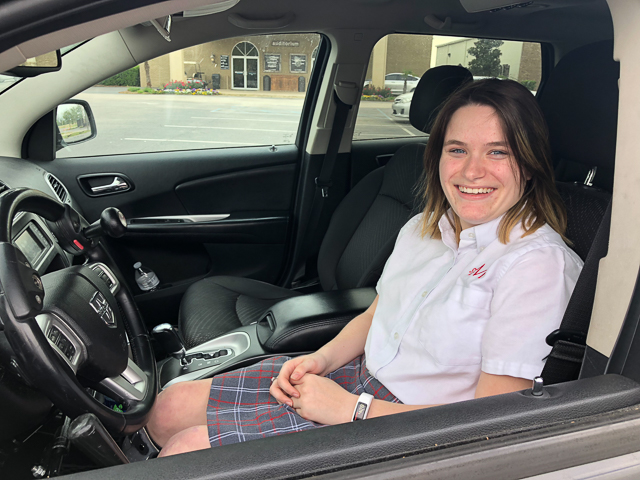If you follow me on Instagram you may have noticed that Sarah Kate is driving now AND that we bought her a brand new car (!!!) She won’t turn sixteen until the end of this year, and I’ll be honest – I’m not a fan of buying new cars for new drivers. As with most things, however, our family’s boots-on-the-ground reality as it relates to driving ended up being a little different from most people.
Although the process of actually learning how to drive was both simple and quick for Sarah Kate, the story of how we got to this point is a bit more detailed and complicated. When we first started looking ahead to the possibility of her learning to drive, I had a hard time finding any information about her options for training or equipment, and just from what little I’ve shared on social media, others are looking for this same information, so I thought a post series might be appropriate. Today’s post is Part One; you can find Part Two here and Part Three here.

The Beginning
A year ago, all we knew for sure was that Sarah Kate would be capable of learning to drive a car. She had driven my dad’s golf cart around his property lots of times, so that was our starting point. We didn’t know if she would need special equipment, who could tell us if she needed special equipment, what that equipment might be, who would install it, who would train her to use it, or even how to find someone who could send us to someone who could answer any of those questions for us.
I started in early September by contacting Sarah Kate’s former physical therapist, thinking maybe she would have had a teenager in similar circumstances before as she’s the clinic owner and has been in practice for many years. She didn’t know, but checked around and got us in touch with Children’s Rehabilitation Service (CRS), a division of the Alabama Department of Rehabilitation Services (ADRS). For a number of reasons (I’ll skip over them for the sake of brevity), Sarah Kate had never been registered with CRS, so we started there. She was assigned a “Care Coordinator” (i.e., case worker) and we jumped through a few more hoops as you have to do if you’re going to receive any sort of government assistance (IEPs, 504s, early intervention, etc., all require a lot of meetings and paperwork to implement, but you probably already know that!)
In early November, I (finally) had a phone number in hand! I was told to call a man at the Lakeshore ADRS facility up in Birmingham. I called right away and left a message, but he never called me back. I didn’t worry about it at the time because Sarah Kate still had a few more weeks before she turned fifteen and was able to take her written test for her permit. In January, after she passed the test, I called him again. After a few tries, I caught him by phone one day only to be told that he wasn’t the guy I needed, and I was transferred over to the admin assistant for the actual guy.
Long story short…things moved VEERRYYY slowly from early September until mid-March, but then? Things really picked up.
The Evaluation
Fast forward to March 19: Sarah Kate was scheduled for a driving evaluation with an occupational therapist in the adaptive driving division of ADRS. Although the evaluator, who specializes in adaptive driving, was based out of Birmingham (250+ miles away), he was in our area that week and met us at a government office in a nearby town. I wasn’t in the room for the evaluation, but I do know that it didn’t involve putting her in a car (or a driving simulator, or trying out any equipment) and was mostly a series of questions. We had provided her medical information in advance and of course the evaluator was able to observe her, as well. We left the evaluation with a recommendation for push-rock style hand controls with a spinner knob and a series of appointments to learn to drive beginning the following Monday.
Clearly, I’ve had a few spins on the adaptive merry-go-round, so I had a number of questions for the evaluator, but the two biggies were:
- How long will it take her to learn to drive with hand controls?
- How much will these hand controls cost?
The short answer to the first question is that adaptive driving training lasts how long it lasts. Some people train for a year and never pass the test, while others finish in a week (those folks typically were experienced drivers before a life event, such as an accident, compelled them to switch to adaptive driving). For Sarah Kate, he estimated it would take her three to four weeks total, though the schedule was unlikely to accommodate her training for three to four consecutive weeks because the trainers cover a large geographic area.
The answer to the second question was $1200-1300, which ended up being pretty close for the cost of the hand controls themselves (the spinner knob was an additional cost, though significantly less than the controls), and the controls are transferable to another vehicle for minimal cost later. Not cheap, for sure, but if I’m being honest…that estimate was about half of what I was expecting, so I was relieved. I had been fearful that the controls would end up being so expensive that we’d need to buy a really cheap car to afford them…and then do the whole thing again in a few years when the car got old and we were worried about her driving it without breaking down.
About the time I started to feel good about the process, Mr. Evaluator Man threw a wrench in the whole thing. He asked me if I was planning to buy a new car (Um…not just no, but HECK NO!) As the father of a teenager himself, he said he tended to agree with me about not buying new cars for new drivers, but he felt I should know that several of the major auto manufacturers offer rebates of up to $1000 toward the cost of mobility equipment on new cars.
I dropped Sarah Kate off at school, called to give Mr. Andi an update, and went home to start researching inexpensive, safe cars for teenagers.

Can’t wait to hear the rest of it!!!
So glad that you’ve been able to navigate the system for Sarah Kate. We’ll done!!! TFS your journey!
Andi,
It turned out much like I thought it would turn out, didn’t it. I am glad she will be on her way toward doing so, and independence on the way. Also, Lakeshore is an awesome resource. I’ve played wheelchair basketball there during tournaments years ago. Keep us posted on how she is doing. Yay!
HA! Yes, it was amazingly easy. I still can’t believe that six weeks ago she hadn’t even started training yet and now she’s finished and has a car!
Hi andi,
I’ve followed your blog for a long time, but rarely comment. I feel as tho I can connect to you in a way now that most people can’t. I just gave birth to my second child born with Down syndrome 🙂 this is baby #5. Child #1 also has downs. It’s not every day that you meet someone who is raising two children that require extra care or have special needs.
Email me sometime if you have time.
I am so happy to see Sarah Kate doing what she sets out to do. And meeting her goals. And accessing her world. I got my 1999 Ford Taurus Wagon serviced at my dealership of choice, and nobody gives me better service. And my car is one of the oldest they maintain regularly. I recently required a new serpentine belt and tensioner, and it took longer than planned, they were prepared to rent me a wheelchair van, if the wagon had to be left overnight, on their dime, and the extra insurance. The dealership owner, treats me like a king, and the car was not bought there at that, he’s a relationship man who super serves me like no other. She communicates well. Make sure she is hooked up with a mechanic who meets her needs, and maintains her vehicle like no other. She needs top notch mechanics, and people who will treat her right. As she can’t get an easy loaner or rental. She also needs to be mindful of the need for regular scheduled maintenance on time. As it prevents breakdowns.
I had a car, before I had hand controls back in 1990, said car my late grandmother bought mom and I, a 1981 Pontiac LeMans wagon. Vocational Rehabilitation bought me hand controls, (they lasted over 14 cars) and the third driver’s ed. Before that my main driving practice (stepdad didn;t think I could drive) was driving my engineer boss’ 1972 Mercedes-Benz 240D, and the station manager’s 1967 Lincoln Continental. The former was willed to me, and his estate paid for hand controls and dealership service for my lifetime (his note in the front seat said, “Kent Teffeteller, my assistant will own this car when I die, the estate will cover the adaptive equipment cost, and dealership repairs and maintenance. He was loyal, the best assistant I ever had, and he earned his crew’s loyalty, he rode in this car when I got it. ” “Kent’s loyal, the best engineer anybody could want. And he was the best I could ever have trained for this profession. ” I still have the Mercedes, and the dealer still maintains it. And I have 1,500,000 miles on various vehicles (mine and company) Cerebral Palsy, Spina Bifida, Hip issues, startle reflex, and all. Sarah Kate has over 7 years of support Stepdad never gave me, and the Slighs behind her, that is awesome. Mom wanted me driving sooner. Stepdad didn’t. And I have earned a safe reputation. Sarah Kate will be just fine, and superb at whatever she does no matter what she has in front of her physically. Like I am, “She is Adaptive” “NO LIMITS” and SK does what she does like I do at our speed.
What an amazing story!!!